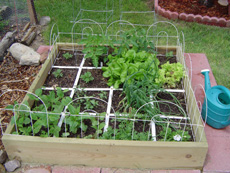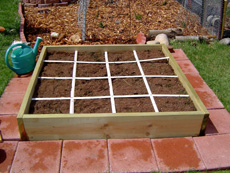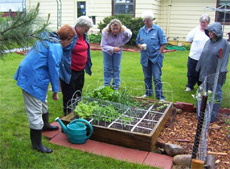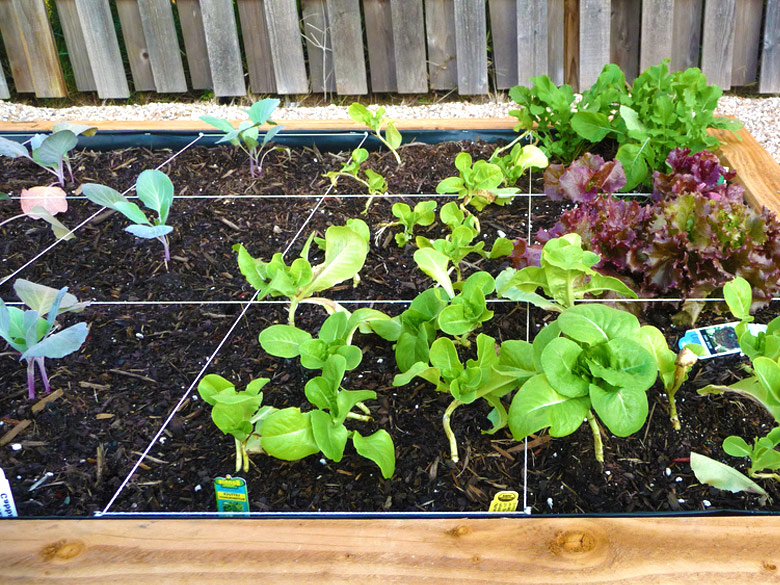Don’t have a lot of room for a garden? With square-foot gardening, you don’t need a lot of room.
What’s the reason people garden? Surveys say it is home grown flavor, hobby, pleasure, pride, satisfaction, and to save money.
Have you ever heard of the square foot gardening method? Square foot gardening is a form of intensive gardening that helps you do all of the above. A fellow by the name of Mel Bartholomew, wrote a book “Square Foot Gardening”. He figured out methods to save time, work, money and space yet get a bountiful harvest.

Most of us are creatures of habit, waiting to till and plant our 20-foot long rows to fill our back yard. It all looks pretty nice when we get it planted, until August comes with the heat, mosquito, drought and weeds. So we must first get rid of the idea of rows, and of planting the whole package of seeds so you can put the package on the stick at the end of the row. Old habits are hard to change, but this system works!.
What is the square foot method? First, lay out your garden within as many 4-foot squares “blocks” as you feel you need. Pick a sunny location, clear of trees and shrubs; near the house. A block will produce enough food for one person and is easily accessible to all ages and sizes, to handicapped, to children. This 4-foot square block is then divided into sixteen 12-inch by 12-inch squares within the block. To begin, till or spade the block, then lay newspapers or cardboard as underlayment to smother out the weeds. If you want to amend your soil within this block, a good mix is one-third compost, one-third peat moss and one-third vermiculite. Existing soil doesn’t matter, just put the new soil mix over top. Then lay boards, bricks, mulch, sawdust, grass clippings, carpet squares or whatever between your blocks as walkways. Never step on your squares blocks.

Bartholomew worked out ideal spacing for different vegetables. Let’s take lettuce. Lettuce takes 6” space per plant- so you can plant 4 in a 1-foot by 1-foot square. Tomatoes, cabbage, broccoli, peppers, and cauliflower take full spacing (or one plant per square). Peppers and cucumber take 12 inch spacing (or two plants per square). Carrots take a 3 inch per seed spacing (or eight plants per square). Beets and spinach require 4 inch spacing (or 6 plants per square).
Within this square block there are other things to consider. Think about doing succession planting, like planting peppers and radishes together in a square. Pull out the radishes as they mature, leaving the peppers to mature later in season. If you are concerned about needing more, or if you want produce throughout the season, plant a square every two weeks.
How much to plant? For cabbage, how many heads do you want? For onions, pick half and leave half…I plant onions 2 inches apart, then pull every other one for eating as green onions, and leave the others to mature. For radishes, team them with peppers, tomatoes, potatoes, or whatever matures later in the season. For vine crops, I plant one hill ( 6-8 seeds) of each of the squash I want, and I plant two types of cucumbers, watermelon and cantaloupe. Don’t forget to mulch, mulch, and mulch.
Another method of specialized gardening is wide row gardening. The wide row method is just what it says, planting in a band rather than a single row. In my own experience, when I needed lots of garden, my square foot method turned into the wide-row method. It’s a way to produce an abundant amount of vegetables in a limited space.

A singe 1-foot wide and 20-foot long row would be equivalent to 5 rows planting the old fashioned way. The wide row crowds out weeds, takes less water, fertilization is conserved and there is overall less work. Take beans for instance – instead of several single rows, I plant 2 rows in the wide row method, mulch between, make ditches or lay my soaker hose in between. Instead of a 20-inch rows each of red radishes, white radishes, lettuce, spinach, carrots, beets and onions, I make a row as wide as my rake and intensive plant all of these in approximately two-foot long section of my twenty foot row. I do the same for starting my seeds for tomatoes, broccoli, brussel sprouts, cabbage, peppers…then when they are a couple inches high I transplant them out to their proper spacing in a wide row. Corn can also be intensive planted. And if you are short on space, plants that vine can be trained to use a trellis and thus use vertical space.
Regardless how you plant, as the plants develop make sure to thin them to have proper space. As you harvest, add compost.
Raised beds, another method of specialized gardening, have advantages and disadvantages. If your garden area is in a wet area, or if the area has poor drainage and heavy clay, raised beds might be a good option. The disadvantage of raised beds is that they have tendency to dry out fast, especially in sandy soil. So, in this area of drought, perhaps raised beds might not be a wise choice.
Maybe this is the year you want to take control of your garden and try a new method, designed for efficiently using your space, time and water.
Learn more about square foot gardens here.
By Donna Adrian
South Central South Dakota Master Gardener
(Reprinted with permission by the author.)

